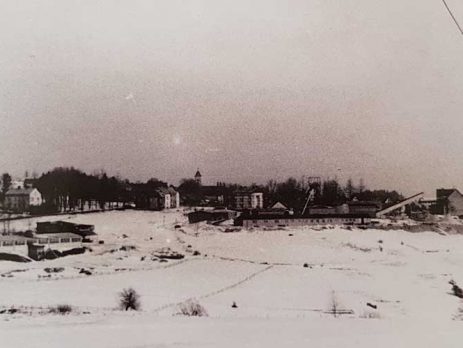Brief history of the mining of Pb-Zn ores in Horní Město after 1945
After the end of World War II, there were changes in the development of the mining industry. The change occurred as a result of the concentration of Soviet influence on Czechoslovakia. Another factor was the nationalization of mining enterprises. The extensive use of mineral resources and the growing raw material and energy demand of industry led to the use of poor and often low-quality domestic resources, into which state subsidies flowed. To ensure raw material security, funds were spent on the exploration of mineral resources in our territory.
The search survey was carried out near Ruda, Tvrdkov, Horní Město, Rýmařov and from Dolní Moravice to Mala Morávka. It was focused on polymetallic ores containing lead, zinc and silver. In the vicinity of the village of Horní Město, ore deposits of 1400 m in length were discovered with the help of boreholes, which extended to a depth of 300 m. These boreholes were carried out in 1954 in the main deposit in Horní Město, later directly in the buildings and gardens of this village. On the basis of a survey carried out by the Czech-Moravian Ore Survey, the exact location of the ore deposit and, among other things, the location of older mine workings located directly in the cadastre of Horní Město, such as St. Magdalena Kluft, Ignatius pit. Gradually, the entire deposit in the cadastre of Horní Město was covered by 115 surface wells, one of which reached a depth of up to 1,200 meters. This well was located near the road in the direction of Skály – Rešov.
In the northeastern part of the Upper Town, the Jaromír shaft was excavated, reaching a depth of 175 m, and 2,200 m of corridors were excavated from it. On the southern edge of Horní Město, the Josef tunnel was excavated with its mouth at an altitude of 614 m above sea level, which followed the ore deposit, discovered by wells from the surface. Next, the New Pit was excavated in the southwestern part of the village, which reached a depth of 147 m and was connected by chimneys and corridors to the Josef tunnel and the Jaromír shaft. The tailings extracted during this deep mining were crushed and deposited on a dump near the New Pit. The crushed material was continuously taken away and used for the needs of the village and its surroundings, therefore there was no increase in the size of the dump.
As of 1.5. In 1965, the Rudné doly Jeseník deposit was taken over as a mining enterprise from the Geological Survey of the District of Brno. This was followed by the stage of technical preparation for mining, construction or modification of surface objects and the excavation of mine shafts. The work was carried out with the help of workers from the RD Horní Benešov plant, to which the Horní Město operation was connected. There were also technical workers from RD Jeseník who collaborated with research organizations and university workplaces. Mining activity from the extractions was started in 1966 and an extraction area of 0.9 km2 was determined. Mining continued until 1970, during which time 216,617 tons of Zn-Pb-Ag ore with an average metallicity of 2.50% Zn and 0.50% Pb were mined here. In 1968, the highest extraction of 60,330 tons was achieved. A total of 2,130 m of corridors and 1,221 m of chimneys were excavated.
The metallurgy of the mined ores was acceptable, and the landfill mining method was used for mining the deposit bodies. Another mining method was the free cut method, which is used in deposits with solid host rock. The method makes it possible to achieve high performance at low costs, and the advice obtained is minimally contaminated. The cleared areas remained vacant after the end of mining. The chamber-pillar mining method was used for mining bearing bodies with an inclination of less than 50°. The method consisted in mining the deposit in chambers of regular shapes, which were separated by pillars in regular rows.
In 1970, mining was prematurely terminated for economic reasons, which also included declining metallurgy. The mined ore was not processed in the Upper Town, it was only crushed on the surface and temporarily stored. This was adversely affected by the necessity of transporting the mined tailings from Horní Město to the treatment plant of the RD Horní Benešov plant, almost 40 km away, where the mined tailings were processed by selective flotation together with ore from the Horní Benešov deposit. The total yields from mining were lower than expected, therefore mining work in Horní Město was stopped on 9/30/1970. This was followed by securing the mine and liquidation work. The mine premises were flooded with water, selected open-pit mining works, such as the Jaromír pit, were covered with aggregate.
In November 2006, the mining area of the Horní Město deposit was canceled and a construction closure was established over the mined part of the deposit. Legislative work connected with the termination of mining activities at this location is handled by DIAMO s.p., through the spin-off plant GEAM Dolní Rožínka, the operation of Rudné doly Jeseník, based in Zlaté Horá. Since 2007, the existing protected deposit area has been changed, which included two deposits: No. 3130300 Horní Město and No. 3130401 Horní Město-Šibenice. The newly established protected deposit area was designated No. 3040100 Horní Město with an area of 88.77 ha. On the territory of the municipality of Tvrdkov there is another protected deposit area No. 3231100 Ruda u Rýmařova-sever with an area of 13.7 ha.

